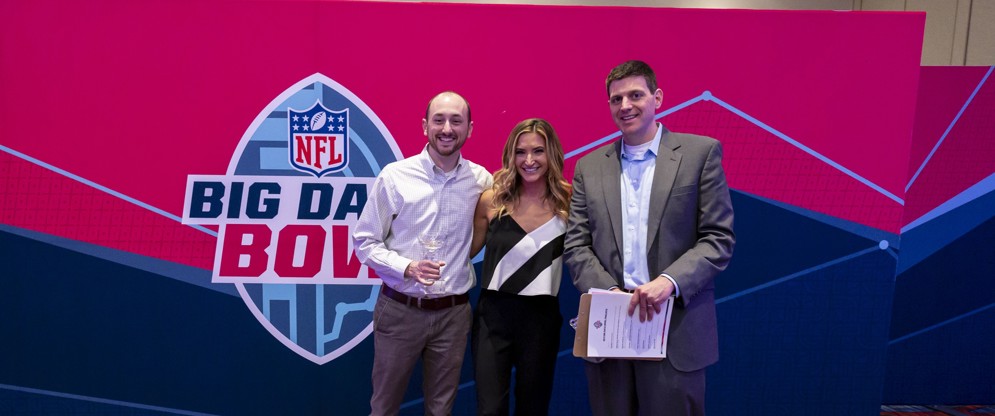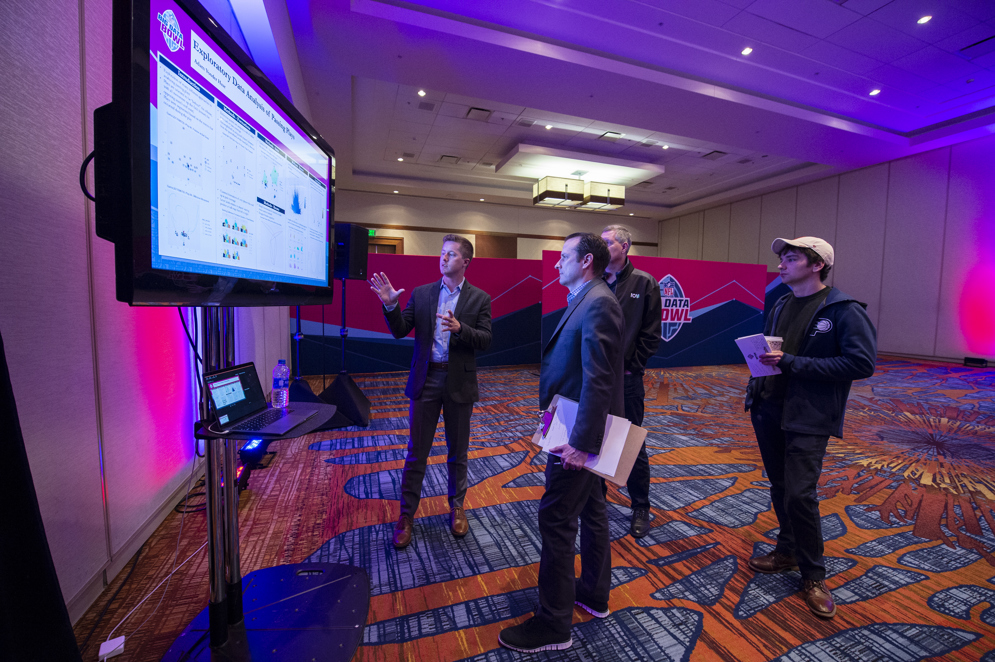The Extra Point A Conversation with Two Big Data Bowl Finalists
October 10, 2019

The 2020 Big Data Bowl is here! And to help mark the occasion, we’re flashing back to the inaugural event to chat with two finalists from the 2019 contest – Nathan Sterken and Adam Vonder Haar. Both contestants earned a trip to the NFL Scouting Combine to present their reports, with Nathan taking home the open entry grand prize and Adam being a finalist.
In addition to their success at the Big Data Bowl, they both also earned new jobs in football analytics following the competition – Adam with the Dallas Cowboys, and Nathan with Telemetry. We spoke with them about their reports, memories from presenting at the Combine and their new roles.
Michael Lopez (Director of Football Data and Analytics, NFL): Tell us a bit about your background in analytics and football.
Nathan: I've always loved football. My playing career peaked in fourth grade so my football background is as a fan. I grew up near Ann Arbor so the University of Michigan is my favorite team. I've been doing analytics professionally for over 10 years in a few industries — from analyzing employment data at the Labor Department to polling and TV data with political campaigns and online behavior with technology companies.
Read Nathan's winning report - RouteNet: a convolutional neural network for classifying routes
Adam: My interest in analytics and football began about five years ago, around the same time DraftKings and FanDuel were becoming more popular as an alternative to traditional redraft fantasy leagues. I had always enjoyed playing fantasy football with my friends growing up, but it wasn't until I got interested in doing daily fantasy more seriously that I forced myself to learn to code because the copying and pasting into Excel wasn't cutting it anymore. At some point, what was initially a means to an end in coding became what I enjoyed the most, and the analysis became more interesting to me than my results in fantasy football.
Michael: Why did you enter last year’s Big Data Bowl?
Nathan: Lots of reasons. I'd wanted to get my hands on the NFL player tracking data ever since reading about it; I was interested by the research prompt I answered (identify the best receiver routes), since I’d never seen any large-scale analysis of that topic; and since the finals were at the Combine, I figured this was my best shot at getting to run the 40 (and to meet people working in this space).
Adam: The biggest reason I entered last year’s Big Data Bowl was pure curiosity about the data and excitement about the process of working with this new data. Working with tracking data is difficult, and if you don’t enjoy the process at least a little bit, it’s easy to give up on it. I also saw it somewhat as a challenge to myself and as a learning opportunity to improve my skill set. Lastly, there was definitely some motivation around potentially going to the Combine and getting my work in front of teams, but both of those felt like such a long shot to me that I couldn’t rely on them for my main motivation.
Read Adam's report - Exploratory data analysis of passing plays using NFL tracking data
Michael: Give us your one paragraph elevator pitch — what was your entry about last year?
Nathan: I demonstrated that you can automate some of the classification work that is typically done by hand and then analyze plays at scale — specifically, I trained a computer to recognize receiver routes using the player tracking data and then computed efficiency metrics for route combinations. The finding: throw it deep (or at least threaten to).
Adam: My entry last year was centered around exploring several potential techniques to discover how an offense can get receivers more open. I used several different methods to classify receiver routes, looked at how different combinations of routes result in greater separation for receivers, and used convex hulls to characterize defender spacing.

Nathan Sterken walks through his winning report at the 2019 Big Data Bowl.
Michael: What is one memory of the event that stands out as you look back?
Nathan: Seeing head coaches in the hallways was fun, but the stand-out moment was discussing my research with the analytics staff from several clubs and the other folks who attended the event. I made connections with several clubs and got to meet a couple of the authors I cited in my paper.
Adam: One of my favorite memories of last year’s event was meeting the many brilliant, like-minded individuals who also submitted entries. Being able to talk football and football analytics specifically in-depth, listening to novel ideas everyone had, and, in general, just hanging out with each other at the Combine made the experience especially memorable.
Michael: Next Gen Stats can be tricky. What would your recommendation be for a first-timer dealing with NFL player tracking data?
Nathan: Football coaches have the best advice here: take it one play at a time. If you start by focusing on one play (preferably one where you can find video for it so you know exactly what happened) and doing some simple plots and statistics, you can get your arms around the format of the data without worrying about the size of the overall data set. That said, you’ll want to do that exploration in a programming language like Python or R because you’ll need to be able to quickly scale up your analysis to crunch through each play.

Adam Vonder Harr discusses his report, Exploratory data analysis of passing plays using NFL tracking data.
Adam: As tempting as it can be to dive into analysis immediately, I think it’s important to take your time cleaning and understanding the data as much as possible first. The tracking data is not without anomalies and errors occasionally, and even the good data often must be modified so that everything is oriented and normalized consistently. Spending the effort to prepare the data thoroughly makes the analysis much easier when you get to that point.
Michael: Tell us a bit about your new roles with Telemetry and the Dallas Cowboys, respectively. How have you been able to help?
Nathan: Telemetry helps clubs with game preparation and player analysis by making it quick and easy to find video of any type of play by any player. Specifically, they use the player tracking data to create a rich set of annotations on each play and then pair that with a searchable video database. I’ve helped them by building modeling pipelines that use the player tracking data to identify additional aspects of the play, like the type of coverage that was played by the defense.
Adam: I am now a Football Research Analyst with the Dallas Cowboys. Our team’s responsibilities range from scouting and personnel, to assisting coaches with game planning and opponent scouting, to sports science and player health. I spend a lot of time working with the tracking data specifically, trying to discover ways we can use it to make our processes more efficient and improve our ability to make evidence-based decisions.